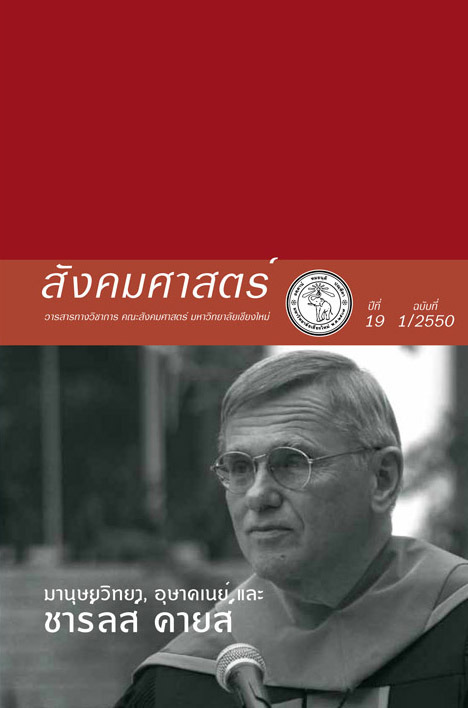จากชาร์ปถึงคายส์: เส้นทางของกระบวนทัศน์วิธีวิทยาศึกษาสังคมไทย
Main Article Content
บทคัดย่อ
ในบทความนี้ พวกเราพิจารณาเส้นทางของกระบวนทัศน์วิธีวิทยา (me-thodological paradigm) ในวงวิชาการไทยศึกษาชุดหนึ่งผ่านตัวอย่างข้อเขียนของศาสตราจารย์ชาร์ลส์ คายส์ พวกเราใช้แนวคิดเรื่องกระบวนทัศน์ ซึ่งนำเสนอโดยโธมัส คูห์น (1962) เพื่อแสดงให้เห็นว่านักเรียนมานุษยวิทยาอเมริกันท่านหนึ่งเติบโตในถนนสายวิชาการและผ่านกระบวนกาเปลี่ยนแปลงทางอัตลักษณ์ภายใต้กรอบกระบวนทัศน์หรือธรรมเนียมวิชาการชุดหนึ่งได้อย่างไร พวกเราค้นคว้าและอ่านข้อเขียนวิชาการ ด้านไทยศึกษาและเอเชียอาคเนย์ศึกษาของอาจารย์คายส์ตลอดวิชาชีพของท่านพร้อมกับนำเสนอว่ากระบวนทัศน์วิธีวิทยาของอาจารย์คายส์ แท้ที่จริงก็คือ สายสัมพันธ์พิเศษระหว่างอาจารย์กับลูกศิษย์ อาจารย์คายส์คือผู้สืบทอดและพัฒนากระบวนทัศน์วิธีวิทยาแห่งสำนักมหาวิทยาลัยคอร์แนลต่อจากอาจารย์คนสำคัญของท่าน ซึ่งได้แก่ ศาสตราจารย์ลอริสตัน ชาร์ป พวกเราเรียกกระบวนทัศน์ดังกล่าวว่า “กระบวนทัศน์วิธีวิทยาจากชาร์ปถึงคายส์” หัวใจหลักของกระบวนทัศน์ดังกล่าวก็คือ การให้ความสำคัญกับความเป็นมนุษย์ เน้นการศึกษาวิจัยกระบวนการเปลี่ยนแปลงไปสู่ภาวะความทันสมัยและการสร้างชาติ รวมทั้งผลกระทบต่างๆ ของกระบวนการดังกล่าว เน้นรอยแยกหรือจุดหักเหของประวัติศาสตร์ เน้นความสำคัญของการเชื่อมโยงชุมชนท้องถิ่นขนาดเล็กเข้ากับรัฐ ภูมิภาคและระบบเศรษฐกิจการเมืองของโลกที่สำคัญ กระบวนทัศน์วิธีวิทยาจากชาร์ปถึงคายส์เน้นความสำคัญของการวิเคราะห์ตีความหมายที่ลุ่มลึกและละเอียดอ่อนของการเปลี่ยนแปลง
พวกเรานำเสนอด้วยว่า กระบวนทัศน์วิธีวิทยาจากชาร์ปถึงคายส์มีความโดดเด่นเป็นพิเศษในการอธิบายและทำความเข้าใจการเปลี่ยนแปลงไปสู่ภาวะความทันสมัย รวมทั้งผลกระทบด้านต่างๆ ที่เกิดขึ้นผ่านสภาพวิกฤติการณ์ทางวัฒนธรรมหรือรอยแยกที่เป็นจุดหักเหของประวัติศาสตร์ กระบวนทัศน์วิธีวิทยาดังกล่าวเน้นความหนักแน่นและละเอียดอ่อนของการใช้ข้อมูลหลักฐานทางชาติพันธุ์วรรณนาข้อมูลทางประวัติศาสตร์ ควบคู่ไปกับการอ้างอิงแนวคิดทางทฤษฎีที่เน้นความสำคัญของมนุษย์และคุณค่าทางวัฒนธรรม กระบวนทัศน์วิธีวิทยาจากชาร์ปถึงคายส์ช่วยแก้ข้อด้อยของแนวการศึกษาแบบวิวัฒนาการนิยม หน้าที่นิยม และโครงสร้างนิยม แต่ไม่ได้ก้าวหน้าไปถึงขั้นนำเสนอทางเลือกทางออกในการแก้ปัญหาทางเศรษฐกิจ การเมือง ที่เกิดขึ้น พลังของกระบวนทัศน์นี้อยู่ที่การตีความทางทฤษฎีที่ลุ่มลึกและละเอียดอ่อน รวมทั้งการให้คำอธิบายปรากฏการณ์ด้วยฐานข้อมูลที่หนักแน่น เป้าหมายทางการเมืองของกระบวนทัศน์ วิธีวิทยานี้อยู่ที่การรรื้อถอนอคติวิชาการตะวันตก (โดยเฉพาะในสหรัฐอเมริกา) โดยการนำเสนอมุมมองและวิธีคิดของคนในและนักวิชาการในภูมิภาคขึ้นมาเทียบเคียงเพื่อให้องค์ความรู้มานุษยวิทยาและอุษาคเนย์ศึกษาเกิดการสนทนาตอบโต้และวิพากษ์วิจารณ์ซึ่งกันและกันมากยิ่งขึ้น
Article Details
ข้อเขียนทั้งหมดทีปรากฏในวารสารสังคมศาสตร์ เป็นความคิดเห็นของผู้เขียนโดยเฉพาะ มิใช่ทัศนคติของคณะสังคมศาสตร์ มหาวิทยาลัยเชียงใหม่ หรือกองบรรณาธิการวารสารสังคมศาสตร์
เอกสารอ้างอิง
จุฬาลงกรณ์มหาวิทยาลัย, หน้า 113-164.
ดารารัตน์ เมตตาริกานนท์ (2546) การเมืองสองฝั่งโขง: ขบวนการนักการเมืองท้องถิ่นภาคอีสาน. กรุงเทพมหานคร: สำนักพิมพ์มติชน.
ผู้สื่อข่าวพิเศษของเรา [นามแฝงของชาร์ลส์ เอฟ. คายส์] (2511) “จดหมายจากอีสาน”. สังคมศาสตร์ปริทัศน์. 6, 1: 89-95.
ยศ สันตสมบัติ (2530) จากวานรถึงเทวดา: มาร์กซิสม์และมานุษยวิทยามาร์กซิสม์. กรุงเทพมหานคร: สำนักพิมพ์มหาวิทยาลัยธรรมศาสตร์.
ภาษาอังกฤษ
Anasaranasasanakiarti, Phra Khru and Charles F. Keyes (1980) “Funery Rites and the Buddhist Meaning of Death: An Interpretive Text from Northern Thailand.” Journal of Siam Society. 68, 1: 1-28.
Embree, John F. (1950) “Thailand – A Loosely Structured Social System.” American Anthropologist. 52: 181-193.
Foucault, Michel (1972) The Archaeology of Knowledge. Alan M. Sheridan Smith, tr. London: Tavistock Publications.
Foucault, Michel (1977) Discipline and Punish: The Birth of the Prison. Alan M. Sheridan, tr. New York: Vintage Books.
Foucault, Michel (1980) Power/Knowledge : Selected Interviews and Other Writings, 1972-1977. Colin Gordon et al., tr. New York: Pantheon Books.
Geertz, Clifford (1973) The Interpretation of Cultures: Selected Essays. New York: Basic Books.
Hanks, Lucien M. (1962) “Merit and Power in the Thai Social Order”. American Anthropologist. 64, 6(December): 1247-1461.
Keyes, Charles F. N.d. “Ban Nong Tun: A Thai-Lao Village in Central Northeastern Thailand”. Unpublished Manuscript.
_____. (1966) “Ethnic Identity and Loyalty of Villagers in Northeastern Thailand.” Asian Survey. 6, 7 (July): 362-369.
_____. (1967) Isan: Regionalism in Northeastern Thailand. Data Paper No. 65. Ithaca: Southeast Asia Program, Department of Asian Studies, Cornell University.
_____. (1975) “Tug-Of-War for Merit: Cremation of a Senior Monk”. The Journal of Siam Society. 63, 1: 44-62.
_____. (1976) “In Search of Land: Village Formation in the Central Chi River Valley, Northeastern Thailand.” Contributions to Asian Studies. 9: 45-63.
_____. (1977a) The Golden Peninsula: Culture and Adaptation in Mainland Southeast Asia. New York: Macmillan Publishing.
_____. (1977b) “Millennialism, Theravada Buddhism, and Thai Society.” The Journal of Asian Studies. 36, 2(February): 283-302.
_____. (1978) “Ethnography and Anthropological Interpretation in the Study of Thailand.” In The Study of Thailand. Papers in International Studies, Southeast Asia Series No. 54. Eliezar Ayal, ed. Athens, Ohio: Ohio University Center for International Studies, Southeast Asia Program, pp. 1-60.
_____. (1983a) “The Observer Observed: Changing Identities of Ethnographers in a Northeastern Thai Village.” In Fieldwork: The Human Experiences. Robert Lawless, Vinson H. Sutlive, Jr., and Mario D. Zamora, eds. New York: Gordon and Breach, pp. 169-194.
_____. (1983b) “Economic Action and Buddhist Morality in a Thai Village.” The Journal of Asian Studies. 42, 4(August): 851-868.
_____. (1984) “Mother or Mistress but Never a Monk: Buddhist Notions of Female Gender in Rural Thailand.” American Ethnologist. 11m 2 (May): 223-242.
_____. (1986) “Ambiguous Gender: Male Initiation in a Buddhist Society.” In Religion and Gender: Essays on the Complexity of Symbols. Caroline Bynum, Stevan Harrell, and Paula Richman, eds. Boston: Beacon Press, pp. 66-96.
_____. (1987) Thailand Buddhist Kingdom as Modern Nation-State. Boulder, Colorado: Westview Press.
_____. (1990) “Buddhist Detachment and Worldly Gain: The Economic Ethic of Northeastern Thai Villagers.” In Yu Muang Thai: Ruam Botkhwam Thang Sangkhom Phua Pen Kiat Dae Satsatrachann Saneh Chamarik [In Thailand: Collected Essays in Honor of Professor Saneh Chammarik]. Chaiwat
Satha-Anand ,ed. Special Issue of Ratthasat San (Journal of Political Science, Thammasat University). 16, 1-2: 271-298.
_____. (1991) “The Proposed World of the School: Thai Villagers’ Entry into a Bureaucratic State System.” In Reshaping Local Worlds: Formal Education and Cultural Change in Rural Southeast Asia. Charles F. Keyes, ed. Monograph No. 36. New Haven: Yale University Southeast Asia Studies,
pp. 89-130.66
Keyes, Charles F. (1994) “Lauriston Sharp and the Anthropological Study of Thailand: Some Reflections.” Thai-Yunnan Project Newsletter (Australian National University). 25: 1-5.
Keyes, Charles F. (1995) “Hegemony and Resistance in Northeastern Thailand.” In Regions and National Integration in Thailand 1892-1992. Volker Grabowski, ed. Wiesbaden, Germany: Harrassowitz Verlag, pp.154-182.
Keyes, Charles F. (2000) “Fieldwork as History: Letters between Two Researchers in Northeastern Thailand in 1963.” In Friends in the Field: Four Decades of Anthropological and Sociological Studies in Thailand: A Symposium in Honor of A. Thomas Kirsch. Chiang Mai: Privately Published, pp. 7-24.
Keyes, Charles F. (2002a) “Weber and Anthropology.” Annual Review of Anthropology. 31: 233-255.
Keyes, Charles F. (2002b) “Migrants and Protestors: ‘Development’ in Northeastern Thailand.” Keynote Address presented in the 8th International Conference on Thai Studies, Nakhon Phanom, Thailand, January 9-12.
Keyes, Charles F. (2003) “Suriya Smutkupt: An Exemplary Ethnographic Fieldworker.” In Khon La Fan: Tamnan Manutsayawitthaya Isan [The Dream Hunter: A Legend of an Anthropologist from Northeastern Thailand]. Pattana Kitiarsa, ed. Nakhon Ratchasima, Thailand: Sombun Printing, pp.
130-136.
Keyes, Charles F. (2007) “Remembering Anthropology at the University of Washington”. Paper presented at a colloquium in the Department of Anthropology, University of Washington, May 16.
Keyes, Charles F., Laurel Kendall, and Helen Hardacre, ed. (1994) Asian Visions of Authority: Religion and the Modern States of East and Southeast Asia. Honolulu: University of Hawaii Press.
Kuhn, Thomas S. (1962) HYPERLINK “http://en.wikipedia.org/wiki/The_Structure_of_Scientific_Revolutions” \o “The Structure of Scientific Revolutions” The Structure of Scientific Revolutions. Chicago: University of Chicago
Press.
Sharp, Lauriston. (1952) “Steel Axes for Stone-Age Australians.” Human Organization. 17, 2: 17-22.
Sharp, Lauriston. (1962) “Cultural Continuities and Discontinuities in Southeast Asia.” The Journal of Asian Studies. 22, 1(November): 3-11.
Skinner, G. William and A. Thomas Kirsch. (1975) “Introduction.” In Change and Persistence in Thai Society: Essays in Honor of Lauriston Sharp. G. William Skinner and A. Thomas Kirsch, eds. Ithaca: Cornell University Press, pp. 1-24.
Skinner, G. William and A. Thomas Kirsch, eds. (1975) Change and Persistence in Thai Society: Essays in Honor of Lauriston Sharp. Ithaca: Cornell University Press.
Somchai Phatharathananunth. (2006) Civil Society and Democratization: Social Movements in Northeast Thailand. Copenhagen: NIAS Press.
Tanabe, Shigeharu and Charles F. Keyes. (2002) “Introduction.” In Cultural Crisis and Social Memory: Crises of Modernity in Thailand. Laso. London: RouteldgeCurzon, pp. 1-39.


